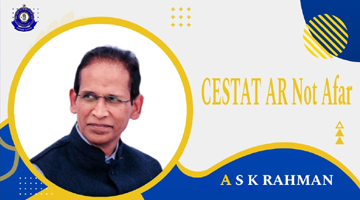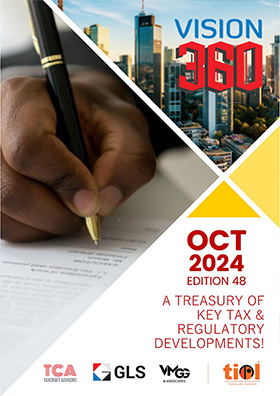Law by majority - tear the judicial veil
SEPTEMBER 14, 2022
By Vijay Kumar
SUPPOSE there is an issue whether a particular service is liable to GST
1. A three member bench of the Supreme Court decided by majority of two to one that it is liable (2+1)
2. This case is referred to a larger bench of five judges and this bench by a majority of three to two over-ruled the first decision and held that it is not liable to GST. (3+2)
Now the real situation is that we have eight judges, all of them of equal rank of the same Supreme Court and actually four held against and four for the issue, but as per the law/practice now, the second judgement holds, because it is the decision of a larger bench.
This issue was before the Supreme Court last week.
I had raised this issue eight years ago in my daily column DDT 2349 08.05.2014
In State of AP v Kone Elevators - 2005-TIOL-30-SC-CT-LB - a three member bench of the Supreme Court held that the transaction of supply of lift was a contract of 'sale' and not a 'works-contract'. This was a unanimous decision of three judges. This was referred to a larger bench of five judges and in Kone Elevator India Pvt Ltd Vs State of Tamil Nadu And Ors - 2014-TIOL-57-SC-CT-CB. Four judges held that it was a works contract while one judge held that it was a Sales contract.
Now out of eight judges, four held it as works contract and four as sales contract. Isn't this equally balanced?
Coming back to the present:
There are two groups of judgements
|
Kothari Products Group
|
|
Agra Belting Works Group
|
|
Kothari Products Ltd. vs. Government of A.P., (2000) 9 SCC 263
|
|
Commissioner, Sales Tax U.P. vs. M/s Agra Belting Works, Agra (1987) 3 SCC 140
|
|
State of Orissa vs. Radheshyam Gudakhu Factory, (1987) 68 STC 92
|
|
Sales Tax Officer, Section IX, Kanpur vs. Dealing Dairy Products and Another, 1994 Supp. (2) SCC 639
|
| |
|
State of Bihar and Others vs. Krishna Kumar Kabra and Another, (1998) 108 STC 1.
|
Whereas the Kothari Products line of judgments had held that an entry under a sales tax statute which only specifies rate cannot be used to eat into an exemption entry, the Agra Belting Works line of judgments states the exact opposite, which is that the charging section, the rate of tax section, and the exemption section all form part of one scheme, and when a notification is issued under a rate of tax section, which is subsequent to a notification exempting certain goods, the intention of the legislature is that such exemption then gets withdrawn and makes the sale of such goods liable to tax.
The Supreme Court in Shanti Fragrances - 2017-TIOL-379-SC-CT, observed,
7) It is well settled that in the area of taxation, the question of going to the measure of a tax would arise only if it is found that the charge of tax is attracted.Also, in a recent Constitution Bench judgment delivered by this Court in Commissioner of Income Tax (Central)-I, New Delhi vs. Vatika Township Private Limited, - 2014-TIOL-78-SC-IT-CB, this Court stated that the components which enter into the concept of taxability are well known and distinct.
1. The first is the imposition of tax which prescribes the taxable event attracting the levy.
2. The second is an indication of the "taxable person" i.e. the person on whom the levy is imposed and who is obliged to pay the tax.
3. The third is the rate at which tax is imposed.
4. The fourth is the measure or value to which the levy will be applied for computing tax liability.
The issue of majority was addressed by Justice M.B. Lokur,in Supreme Court Advocates-on-Record Association and Another vs. Union of India, 2015-TIOL-257-SC-MISC-CB
One of the more interesting aspects of Pradeep Kumar Biswas is that out of the 7 (seven) learned Judges constituting the Bench, 5 learned Judges overruled the unanimous decision of another set of 5 learned Judges in SabhajitTewary. Two of the learned Judges in Pradeep Kumar Biswas found that SabhajitTewary had been correctly decided. In other words, while a total of 7 learned Judges took a particular view on an issue of fact and law, that view was found to be incorrect by 5 learned Judges, whose decision actually holds the field today. Is the weight of numbers irrelevant? Is it that only the numbers in a subsequent Bench are what really matters? What would have been the position if only 4 learned Judges in Pradeep Kumar Biswas had decided to overrule Sabhajit Tewary while the remaining 3 learned Judges found no error in that decision? Would a decision rendered unanimously by a Bench of 5 learned Judges stand overruled by the decision of 4 learned Judges in a subsequent Bench of 7 learned Judges? Pradeep Kumar Biswas presents a rather anomalous situation which needs to be addressed by appropriate rules of procedure. If this anomaly is perpetuated then the unanimous decision of 9 learned Judges in the Third Judges case (Special Reference No. 1 of 1998, In Re, (1998) 7 SCC 739) can be overruled (as sought by the learned Attorney General) by 6 learned Judges in a Bench of 11 learned Judges, with 5 of them taking a different view, bringing the total tally of Judges having one view to 14 and having another view to 6, with the view of the 6 learned Judges being taken as the law!
In Ningappa Ramappa Kurbar and Another vs. Emperor, AIR 1941 Bombay, the position in law was explained as:
The Court in that case consisted of five Judges, one of whom, Shah J., dissented from that proposition. The authority of the case may be open to question, since there had been a previous decision of a Full Bench of this Court of four Judges in Queen-Empress v. Mugappa, (1894) 18 Bom 377 (FB), which had reached a different conclusion. Apparently it was considered that five Judges, by a majority of four to one, could overrule a unanimous decision of four Judges, the net result being that the opinion of four Judges prevailed over the opinion of five Judges of co-ordinate jurisdiction. There seems to be very little authority on the powers and constitution of a Full Bench.
There can be no doubt that a Full Bench can overrule a Division Bench, and that a Full Bench must consist of three or more Judges; but it would seem anomalous to hold that a later Full Bench can overrule an earlier Full Bench, merely because the later bench consists of more Judges than the earlier. If that were the rule, it would mean that a bench of seven Judges, by a majority of four to three, could overrule a unanimous decision of a bench of six Judges, though all the Judges were of co-ordinate jurisdiction.
In Harper and Others vs. National Coal Board [1974] 2 All ER 441, the Court of Appeal was faced with a judgment of the House of Lords in Central Asbestos Co Ltd vs. Dodd by five learned Judges. Whereas Lord Reid and Lord Morris took a particular view of the law in favour of Dodd, stating that his claim was not barred, two other learned Judges namely, Lord Simon and Lord Salmon disagreed on the law, and held that his claim was barred. Lord Pearson was stated to be the odd man out. He held that time did not run against Dodd, since Dodd did not appreciate that the appellants were at fault and that his injuries were attributable to their fault. On that ground, he agreed with Lord Reid and Lord Morris, as a result of which Dodd succeeded. However, he went on to say that he agreed with the opinion of the minority as to the proper construction of the statute in law. Faced with this, Lord Denning M.R. set out four interesting propositions on how a ratio is to be discovered and or read in a judgment. He stated:
1. We can only accept a line of reasoning which supports the actual decision of the House of Lords. By no possibility can we accept any reasoning which would show the decision itself to be wrong.
2. The second proposition is that, if we can discover the reasoning on which the majority based their decision, then we should accept that as binding on us.
3. The third proposition is that, if we can discover the reasoning on which the minority based their decision, we should reject it. It must be wrong because it led them to the wrong result.
4. The fourth proposition is that if we cannot discover the reasoning on which the majority based their decision we are not bound by it. We are free to adopt any reasoning which appears to us to be correct, so long as it supports the actual decision of the House.
The Supreme Court in Shanti Fragrances - 2017-TIOL-379-SC-CT, observed,
13) Let us consider a hypothetical example, where a 2 Judge Bench has laid down the law in a particular way. If nine other 2 Judge Benches have followed the first 2 Judge Bench decision, is it open for three learned Judges to overrule all of the 2 Judge Benches i.e. twenty learned Judges? The obvious answer would be yes, because the 3 Judge Bench is really overruling the first 2 Judge Bench decision, which was merely followed by nine other 2 Judge Benches. As against this, however, if a unanimous 5 Judge Bench decision is overruled by a 7 Judge Bench, with four learned Judges speaking for the majority, and three learned Judges speaking for the minority, can it be said that the 5 Judge Bench has been overruled? Under the present practice, it is clear that the view of four learned Judges speaking for the majority in a 7 Judge Bench will prevail over a unanimous 5 Judge Bench decision, because they happen to speak for a 7 Judge Bench. Has the time come to tear the judicial veil and hold that in reality a view of five learned Judges cannot be overruled by a view of four learned Judges speaking for a Bench of 7 learned Judges? This is a question which also needs to be addressed and answered.
And the Bench requested the Chief Justice of India to constitute an appropriate Bench in order to decide as to whether the Kothari Products line or the Agra Belting Works line is correct in law, and also to lay down, as a matter of law, as to whether and to what extent the propositions contained in Ningappa Ramappa Kurbar, Lokur, J.'s observation in Supreme Court Advocates-on-Record Association, and the Harper judgment of the Court of Appeal in U.K. should guide us for the future.
The Supreme Court heard the matter last Tuesday and reserved its judgement. It is reported that a Counsel told the Court, "The referral question is to be given a burial. After 75 years, the position cannot be upset. Verdict of the bench is delivered by the majority. Article 145(5) says that, but nothing in this clause shall be deemed to prevent a judge who does not concur to deliver a dissenting judgment. But that does not mean that the dissenting judgment should add itself to the other dissenting judgments across the board arithmetically. That has been the position for 75 years"
Until Next week















